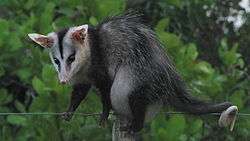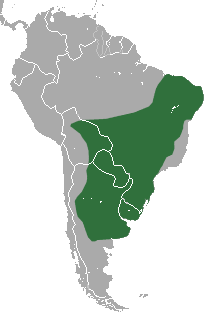White-eared opossum
| White-eared opossum[6] | |
|---|---|
 | |
| Scientific classification | |
| Kingdom: | Animalia |
| Phylum: | Chordata |
| Class: | Mammalia |
| Infraclass: | Marsupialia |
| Order: | Didelphimorphia |
| Family: | Didelphidae |
| Genus: | Didelphis |
| Species: | D. albiventris |
| Binomial name | |
| Didelphis albiventris Lund, 1840 | |
 | |
| White-eared opossum range | |
The white-eared opossum (Didelphis albiventris) is an opossum species from South America. It is found in Argentina, Bolivia, Brazil, Paraguay, and Uruguay.[8]
It is a terrestrial and, sometimes, arboreal animal, and a habitat generalist, living in a wide range of different habitats. It's an omnivorous animal, feeding on invertebrates, small vertebrates, fruits and plants.[8]
For some time, this species was incorrectly known by the name D. azarae, correctly applied to the big-eared opossum. This led to azarae's discontinuation as a species name.[6]
From 1993 until 2002, this species also included the Guianan white-eared opossum (D. imperfecta) and the Andean white-eared opossum (D. pernigra) as subspecies.[6]
It is the team mascot of Clube Náutico Capibaribe, a Brazilian football team from Recife, Pernambuco.
Description
The white-eared opossum is a species of opossums distributed in South America. They are marsupial mammals of the order Didelphis. They are about 1-3 lbs in weight and usually covered by black and grey fur, their white hair covers their ears and face. They have long tails covered by dark hair. They are omnivorous animals feeding on invertebrates, small vertebrates and fruits.[1] White-eared opossums are terrestrial and arboreal animal, living in several types of habitats.[1]
They are also known as Didephis albiventris, morphologically they can be split into 3 groups as albiventris, pernigra, and imperfecta depend on their upper premolar structure and color phases. [3] Didelphis pernigra has a large, upper molar (teeth) and gray coloring on their back. [3] Didephis albiventris and pernigra have small, premolars with gray and black back color. Then the pernigra is significantly larger than the albiventris and imperfecta.[3]
Distribution and habitat
White-eared opossums are distributed in South America. The opossums of South America are divided in two groups: black ears and white ears. [2] The white-eared opossums widely inhabit open areas, mountains and deciduous forests and are commonly found in Argentina, Paraguay, Uruguay, Bolivia, Brazil, Andes and humid forests of Guyana, Suriname and southern Venezuela. [2] Those areas also have disparate environmental characteristics such as rainfall, humidity, water balance and temperature, which means, white-eared opossum can live in several types of environment although the environments are pretty much different. [3]
The white-eared opossum often changes its habitat depending on its breeding season. Usually populations are higher in the wetter seasons from the babies weaning from the mother and venturing out for food sources. “In addition, juveniles grow rapidly and reach high numbers in the wet season and are therefore probably strong competitors for resources in small forest fragments. Thus… reveal great potential to colonize urban environments…”[4] Though normally solitary and nomadic, some will group together in burrows, holes, empty garbage or even under houses.
Diet and seed dispersal
South American opossums such as white-eared opossums are commonly known to be omnivorous. They mainly consume invertebrates such as coleopterans, diplopodsm opiliones and fossorial sankes from the litter stratum with fruit and vertebrates like small birds, mammals and fish. [5] These types of food consumption can be affected by seasons and ages. During drier season, older opossums prefer to consume vertebrates than other food resources.[5] On the other hand, the younger opossums want more to consume invertebrates and fruits during wetter season.[5] However, in general, the diet between young and old opossums is not significantly different but this small difference can favour the survival of younger opossums during wetter season because they can avoid overlapping main food resources too much and give more food to younger opossums during wetter season. [5]
The diet of white-eared opossums also made them as good seed dispersers. [5] Both young and old opossums consume seeds by eating fruits and that potentially spread seeds around. Younger opossums consume smaller fruits than older opossums consume so usually the adult opossums carry bigger seeds than younger opossums. [5] However, proportionally, younger opossums carry bigger seeds and smaller seeds have more chance to pass through gut without any damages.[5] This omnivorous opossum with seed dispersal is important in forest regeneration due to their diet. Since white-eared opossums inhabit several types of environment, they can spread seeds in many different types of habitats. [5]
References
- 1 2 3 Jorge, S.; Hartleben, C. P.; Seixas, F. K.; Coimbra, M. A.; Stark, C. B.; Larrondo, A. G.; Brod, C. S. (2012). "Leptospira borgpetersenii from free-living white-eared opossum (Didelphis albiventris): First isolation in Brazil.". Acta Tropica. 124(2): 147-151. doi:10.1016/j.actatropica.2012.07.009.
- 1 2 3 Tocchio, L. J.; Gurgel-Gonçalves, R.; Escobar, L. E.; Peterson, A. T. (2015). "Niche similarities among white-eared opossums (Mammalia, Didelphidae): Is ecological niche modelling relevant to setting species limits?". Zoologica Scripta. 44(1): 1-10. doi:10.1111/zsc.12082.
- 1 2 3 4 5 Lemos, B.; Cerqueira, R. (2002). "Morphological differentiation in the white-eared opossum group (Didelphidae: Didelphis)". Journal of Mammalogy. 83(2): 354-369.
- 1 2 Cáceres, N. C. (2000). "Population ecology and reproduction of the white-eared opossum Didelphis albiventris (Mammalia, Marsupialia) in an urban environment of Brazil.". Ciencia e Cultura(Sao Paulo) (52(3)): 171-174.
- 1 2 3 4 5 6 7 8 9 Cáceres, N. C. (2002). "Food habits and seed dispersal by the white-eared opossum, Didelphis albiventris, in southern Brazil". Studies on Neotropical Fauna and Environment (37(2)): 97-104.
- 1 2 3 Gardner, A.L. (2005). "Order Didelphimorphia". In Wilson, D.E.; Reeder, D.M. Mammal Species of the World: A Taxonomic and Geographic Reference (3rd ed.). Johns Hopkins University Press. p. 5. ISBN 978-0-8018-8221-0. OCLC 62265494.
- ↑ Costa, L.; Astua de Moraes, D.; Brito, D.; Soriano, P.; Lew, D. & Delgado, C. (2008). "Didelphis albiventris". IUCN Red List of Threatened Species. Version 2008. International Union for Conservation of Nature. Retrieved 28 December 2008.
- 1 2 Eisenberg, John F.; Redford, Kent H. (2000). Mammals of the Neotropics: Ecuador, Bolivia and Brazil.
